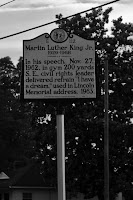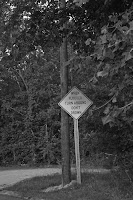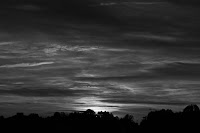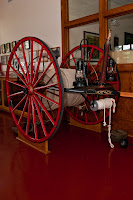Those of you that have Cactus V5s know most of what I will say but I thought I would give a mini initial review for those who have never used them or seen them. First, some photos and comments, then the review.
Below, The pieces of TWO kits. On the left are two transceivers. Next are the connector cables provided. Then the box with one unit inside (nicely and securely packed). Finally on the right a stand and an upside down unit. (Above on the next step up is a Frio - more on that in a moment).
Below a pair of transceivers. On the left unit you can see the port to plug the cable into, the transceiver/receiver selector switch, and the battery tray popped out. On the right unit you can just see the channel selector dial (sorry but too tired from work to reshoot). On the top of each, are the test fire button and the indicator light.
Now the connectors. With each PAIR of units you get ONE 3.5mm plug, one PC Synch cable, and one 6.35 mm plug adapter. Seems like you would need two of each cable but for my setup of two SB-800s and a D300, I don't need the cables. (More on that below).
A detached stand, the screw-in connector and again the T/R switch and the PC port. Some have made comments about the location of the screw receptacle but I haven't had a chance to try it yet. (Been up since 3AM, went to work at 5AM) To be honest, with the Frio, the detachable stand is only needed for when you want to stand the trigger/flash unit on a table or the ground rather than a light stand.
A test. The units are about 125 feet away. Fired every time but the first. Noticed that happened several times and then remembered the SB-800s go to sleep after so many seconds. Adjusted the time to go to sleep and the issue vanished. Not a Cactus issue, just something to be aware of when you set up the flashes. By the way, remember to take the flash units out of remote mode. More on that in a moment. I could have gone further but I was barefoot and this was sufficient for a first test. Flicker post reports response over a football field away! Tested alongside a Pocket Wizard produced Cactus range equal to or further than a Pocket Wizard.
Now about that Frio thingy at the top of the first photo. Fantastic cold shoe. No springs or screws to fool with or loose. Even handles the SB-900 foot! Screws onto your light stand and the flash or Cactus slides in.
The other side of the Frio. $13.99 at Adorama with Free shipping. I got my first one free on the McNalley /Hobby Flashbus tour seminar. (Only cost $99 to get the freebie!)
Now back to the Cactus V5s and how they work. Once I changed the flash out of remote mode everything worked great. Range is greater than I expect to ever use. Quality if very good. The battery tray falls out a little easier than I would design but is ok. The Cactus V5 does NOT pass TTL info through to a flash mounted on top or wirelessly. Everything will be manually set.
With the popup flash in commander mode, the CLS flash unit (set to remote) won't respond. The pop up flash wouldn't rise up enough to fire. You cannot use CLS with the Cactus mounted to the camera. (Not sure why you would but it doesn't work.) Then I connected the Cactus transmitter to the D300 via the PC cable and let it hand rather than be mounted in the hotshoe. Popup set to commander mode. One flash set to remote for wireless CLS and one flash with a V5 receiver. Transmitter connected to camera via PC cable. No go on the V5 flash. Close the flash and V5 units works but CLS flash doesn't. Repeated to confirm. You can have one, either one but not both a the same time.
Apparently this is a D300 issue that I never had reason to discover but when the popup flash is up the PC Synch port doesn't fire and when the popup flash is down, it does fire. This means that you can have CLS or you can have Cactus V5 with manually set flash but you CANNOT HAVE BOTH. (This puts us in a situation similar to Canon camp I found out about at the Flashbus tour. Nikons can have one wireless CLS group set to manual and one group set to TTL but Canon cannot. Canon can't, its either all manual or all TTL, no split functions.
Now I can hear some brains turning thinking -"How about if you leave the popup flash down and put a SB-800 on top of the camera?" No go. If you have a V5 mounted, it will NOT pass the TTL through to the hot shoe on top (Cactus are you listening - this is the next improvement you need to implement). Well how about if you don't mount the V5 and just mount the SB-800 directly on the camera? Now you lose the V5 functionality.
One nice feature of the Cactus V5s is Multi-Channel Triggering. If the receiver triggers are set to any channel labeled in blue (Channels 1 -5 of 16) you can trigger all of them if the transmitter is set to channel 1 (also blue). Change the transmitter to any other channel and it will only trigger than specific channel. Change the receivers to any non-blue channel and the trigger will have to match to trigger them.
At $60 a pair, they are great. The only thing better than this is the new Pocket Wizards that can transmit TTL info. How you priced them lately? Since most of us have only used manual flash Pocket Wizards, the Cactus V5s are terrific.
Would I recommend them? Definitely. Would I do it again with MY money? Yes, I did!












































































